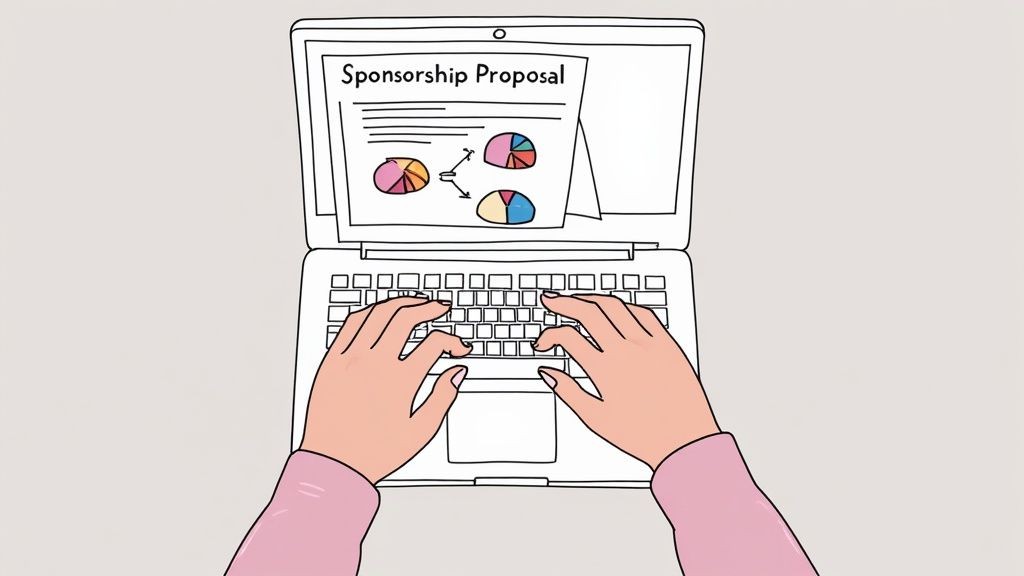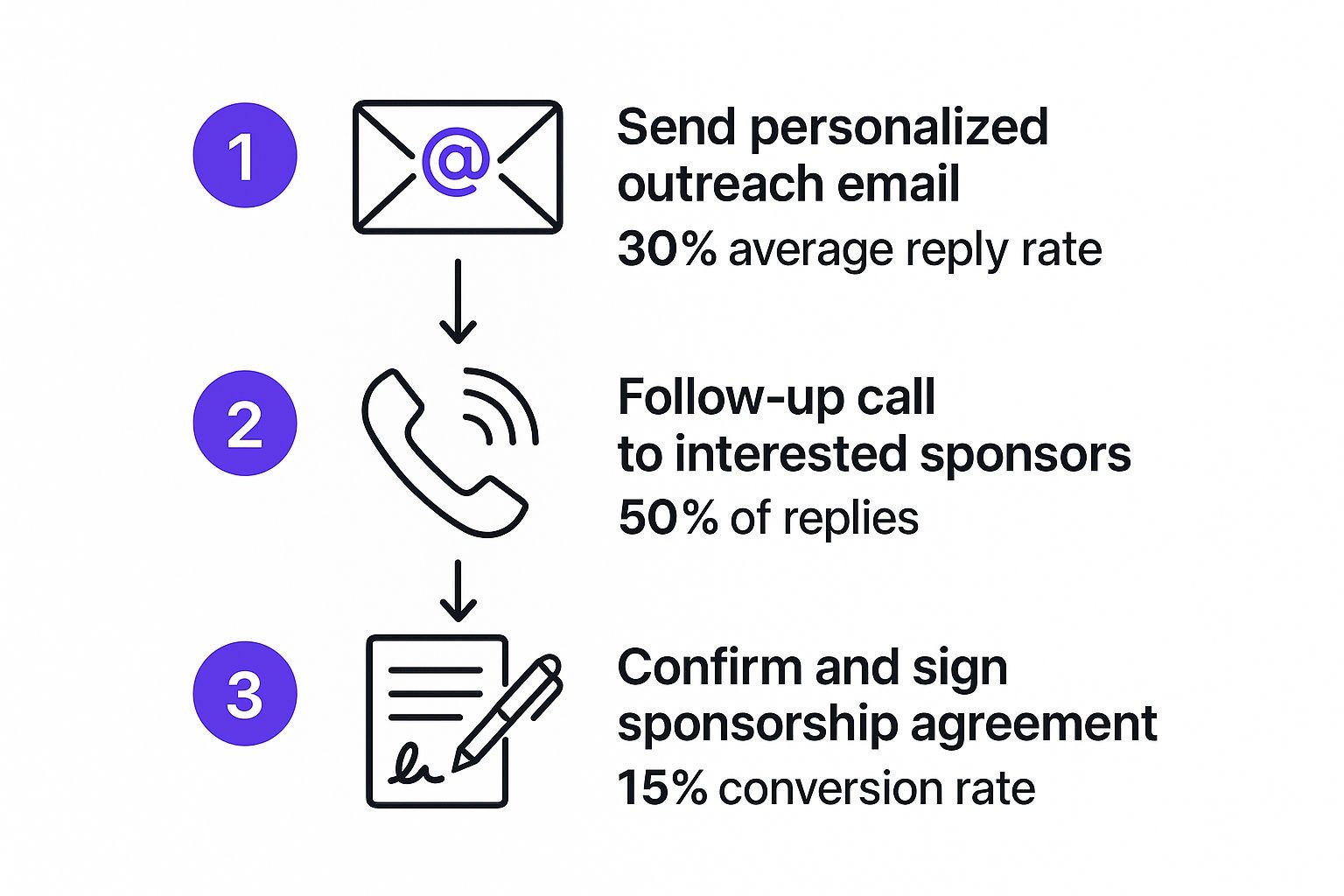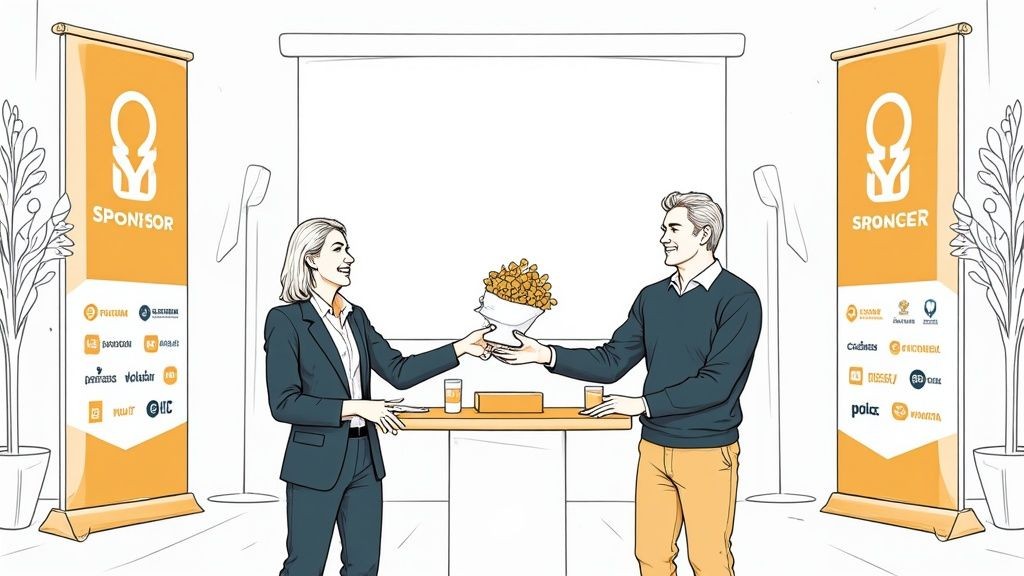Before you even think about writing a sponsorship proposal, you need to get your house in order. Securing sponsors isn't just about asking for money; it's about presenting a rock-solid business case. You have to clearly define your event's value, know your audience inside and out, and have a transparent budget.
This groundwork is what turns a simple request into a compelling partnership opportunity, showing potential sponsors exactly what they'll get in return.
Build a Sponsorship-Ready Event Foundation
You can't sell something you don't fully understand. Sponsors are investors, not donors. They’re investing in access to your audience and the chance to align with your brand. A strong foundation makes that investment a no-brainer.
This goes way beyond a cool theme or a big-name speaker. It’s about building a strategic framework that answers a sponsor's two most important questions before they even have to ask: "Who will I reach?" and "What's in it for me?"
Define Your Event's Unique Value
First things first: what makes your event special? You need to articulate this clearly. Move past the generic mission statement and pinpoint the specific problem you solve or the unique opportunity you create for attendees. This story is the heart and soul of your pitch.
Think through these key elements:
- Mission and Vision: What's the end goal? Are you training a niche community, celebrating an industry win, or connecting local entrepreneurs?
- Unique Selling Proposition (USP): What do you offer that no one else does? Maybe it’s exclusive access to industry giants, a hands-on workshop format, or a laser focus on a booming tech sector.
- Brand Identity: What's the vibe? Is it buttoned-up and corporate, or is it creative, casual, and a bit quirky? Sponsors need to see if their brand fits in with yours.
It’s critical to have this stuff nailed down on all your promotional materials. For a head start, you can find some great guidance on crafting the perfect event landing page that really captures these essential details.
Map Your Audience with Precision
Knowing your audience is, without a doubt, the most important piece of the puzzle. Sponsors aren't buying banner space; they're buying access to a specific group of people. The more detail you can provide, the more compelling your offer becomes.
A sponsor isn't just buying ad space; they're buying a connection with your attendees. The more you know about that audience - their challenges, goals, and motivations - the more valuable your event becomes.
Don't just say you attract "marketing professionals." That’s lazy. Dig deeper and build a detailed persona. Try something like this: "Our attendees are mid-level B2B SaaS marketers, aged 30-45, managing budgets of $250,000+. They're actively looking for lead-gen and automation solutions, and 75% of them have purchasing power."
See the difference? That's the kind of detail that makes a potential sponsor sit up and pay attention.
Create a Transparent and Justified Budget
Finally, your budget is more than just an internal spreadsheet - it's a trust-building tool. A clean, itemized budget shows sponsors you’re organized, professional, and have a clear plan for how their money will be used.
Break down your expenses into obvious categories:
- Venue rental and logistics
- Speaker fees and travel
- Marketing and promotion
- Technology and A/V equipment
- Staffing and operations
When a sponsor can see their $10,000 is going directly to fund the keynote speaker's stage or the all-important networking reception, the investment feels real and tangible. It changes the conversation from, "Can you give us some money?" to, "Will you partner with us to create this specific, high-value experience?"
Find and Qualify the Right Sponsor Partners

Chasing every company with a marketing budget is a surefire way to burn out. The best event organizers know that landing great sponsors isn't about casting a wide net - it's about strategic matchmaking. Real success comes from finding partners whose brand and audience just click with your own.
This process isn't a numbers game. It’s about building a pipeline of qualified leads who are already primed to see the value in what you're offering. When you focus your energy on the right potential partners, your outreach feels more authentic, your pitches land better, and your conversion rates climb.
Pinpoint Brands with Genuine Audience Alignment
First things first: look for brands that are already talking to your people. If you're hosting a conference for fintech startups, a stuffy, old-school bank probably isn't the right vibe. But a modern payment processor or a slick SaaS accounting platform? Now you're talking.
Think about the brands your attendees already use, admire, or follow on social media. A great way to start is by creating a "dream list" of companies that either share your event's values or solve a real problem for your community.
- Look for Industry Overlap: Identify companies in your event's industry or even in adjacent fields that would kill to get in front of your attendees.
- Match Their Customer Persona: Do a little digging into the sponsor's marketing. Are they targeting the same kind of people you are? Check out their social feeds, blog posts, and recent ad campaigns to get a feel for their target audience.
- Find Shared Values: Does the company's mission sync up with your event's theme? If you're running a sustainability conference, you should be looking for brands with a proven, public commitment to environmental causes.
Doing this initial check saves you from wasting hours on companies that were never going to be a good fit, no matter how amazing your proposal is.
Investigate Past Sponsorship Activity
One of the best signs of a great potential sponsor is a history of sponsoring events like yours. This is a massive green flag. It means they already get the value of event marketing and, more importantly, have a budget for it. Your job is no longer to convince them why they should sponsor an event, but why they should sponsor your event.
When a company has sponsored events before, they've already bought into the concept. Your pitch shifts from educating them on the value of event marketing to demonstrating why your specific audience is the one they can't afford to miss.
You can uncover this history with some simple sleuthing. Check the websites of similar conferences or festivals and see who sponsored them last year. Tools like LinkedIn Sales Navigator can also help you see a company's marketing initiatives and track down the right decision-makers. This little bit of research gives you incredible insight into what kinds of activations they like and the level of investment they might be comfortable with.
Use Technology to Build Your Prospect List
Manually digging for every single potential sponsor is a grind. Smart tools can help you build a targeted list way faster, freeing you up to focus on what really matters: personalizing your pitch.
Start by setting up alerts and searches on platforms that track company news and marketing buzz. Here are a few practical ways to do it:
- LinkedIn Sales Navigator: This is fantastic for filtering companies by industry, size, and location. You can also zero in on the specific marketing or partnership managers you need to talk to.
- Industry Publications: Trade magazines and online news sites are a goldmine for spotting brand partnerships and marketing campaigns. This is where you'll find out who's actively spending money on sponsorships.
- Google Alerts: This is a simple but powerful trick. Set up alerts for keywords like
"[Your Industry] sponsor","[Competitor Event] sponsors", or"[Brand Name] partnership". You'll get fresh leads sent right to your inbox.
By combining solid audience alignment, historical data, and a few smart research tools, you stop guessing and start making informed decisions. This strategic approach ensures every company on your list is a qualified lead, which drastically improves your chances of securing the funding your event deserves.
Design Sponsorship Tiers That Sell Themselves
Once you've zeroed in on your ideal partners, it's time to build a sponsorship proposal they simply can't refuse. A generic, one-size-fits-all package is a thing of the past. Today’s sponsors are savvy - they expect a strategic partnership plan, not just a menu of logo placements.
The key is to frame your pitch as a high-return marketing investment. You need to build tiered packages that offer clear, escalating value, making it an easy "yes" for any decision-maker who sees the ROI potential.
Moving Beyond Bronze, Silver, and Gold
While the classic "Gold, Silver, Bronze" model can work, the names are far less important than the value packed into each level. Sponsors need to see a logical jump in benefits that makes the increased investment a no-brainer.
Think about what a modern sponsor really wants. The days of being happy with a logo on a banner are long gone. Brands today demand tangible outcomes.
- Lead Generation: Can you offer them a list of opted-in attendees who visited their booth or scanned a specific QR code?
- Brand Integration: How about making them the official sponsor of the Wi-Fi network, a charging station, or the main networking lounge?
- Content Collaboration: Could they co-host a webinar with you before the event or get featured in a pre-event article? For more ideas on leveraging your event's content, check out our guide to event content marketing.
When you start thinking creatively, you can design benefits that deliver real business results, moving way beyond passive brand awareness.
Structuring Your Sponsorship Tiers for Clarity
A well-structured proposal should make the decision easy for a potential sponsor. They should be able to glance at your tiers and instantly grasp the difference in value.
Here's a sample structure that builds value with each level:
- Supporting Tier (Entry-Level): This is for brands with smaller budgets who still want to be involved. Focus on digital visibility: logo placement on the event website, a mention in email newsletters, and a social media shout-out.
- Presenting Tier (Mid-Level): This level includes everything from the Supporting tier but adds direct engagement opportunities. Think a physical booth space, a short speaking slot in a breakout session, or branded swag in the attendee welcome bags.
- Title Tier (Premium): This is your top-shelf offering, often exclusive to just one sponsor. It bundles all lower-tier benefits with premium placement, like naming rights ("Event Name, Presented by Sponsor Name"), a keynote speaking opportunity, and exclusive access to attendee data (with consent, of course).
The best sponsorship packages don't just list benefits; they tell a story. Each tier should represent a deeper level of partnership and integration into the event experience, making the value proposition clear and compelling.
This tiered approach creates clear entry points for companies with different budgets and marketing goals, allowing them to self-select the investment that makes the most sense.
This is what a typical sponsorship funnel looks like, from the first email all the way to a signed deal.

As you can see, a solid follow-up strategy is crucial. A huge chunk of those initial replies will turn into deeper conversations and, eventually, new partners.
Example Sponsorship Tier Structure
To give you a clearer picture, here’s a sample breakdown of how benefits can scale across different sponsorship levels. This structure is designed to provide tangible value at every price point, making each tier an attractive option for the right partner.
| Benefit | Bronze Tier ($1,000) | Silver Tier ($5,000) | Gold Tier ($10,000) | Platinum Tier ($25,000) |
|---|---|---|---|---|
| Logo on Event Website | Yes | Yes (Prominent) | Yes (Premium) | Yes (Title Placement) |
| Social Media Mentions | 1 Pre-event Post | 3 Pre-event Posts | Pre & Post-event Posts | Dedicated Campaign |
| Email Newsletter Feature | Shared Mention | Dedicated Section | Banner Ad | Exclusive Send |
| Exhibitor Booth Space | N/A | 10x10 Booth | 10x20 Booth | 20x20 Premium Booth |
| Complimentary Tickets | 2 | 4 | 8 | 15 |
| Speaking Opportunity | N/A | N/A | 30-min Breakout Session | 45-min Keynote |
| Attendee List Access | N/A | Post-event (Basic) | Pre & Post-event | Full Access w/ Opt-in |
| Branded Item in Swag Bag | N/A | Yes | Yes | Yes + Exclusive Item |
| Event Naming Rights | N/A | N/A | N/A | "Presented by" Title |
This table illustrates how you can layer benefits to justify higher price points. The goal is to make the jump to the next tier feel like a logical and valuable upgrade for your potential sponsors.
The Rise of Digital and Hybrid Event Sponsorships
The event world is always changing, and sponsorship opportunities now extend far beyond the four walls of a venue. The explosion of virtual and hybrid events has created a whole new playbook of digital integrations that are highly trackable and incredibly valuable.
This shift is changing how marketing dollars are spent. For example, the global sports sponsorship market is expected to rocket from $64.1 billion in 2024 to an eye-watering $144.9 billion by 2034, with digital placements driving a huge portion of that growth. Brands are ditching simple signage for immersive digital experiences like VR activations, branded virtual lounges, and sponsored live-stream overlays.
Consider weaving these digital-first benefits into your tiers:
- Sponsored Content: Feature a sponsor in a pre-event blog post or a video interview.
- Virtual Booths: Give sponsors a dedicated digital space to share resources, chat with attendees, and capture leads.
- App Integration: Sell sponsored push notifications or banner ads within your official event app.
By including these modern benefits, you’re sending a clear signal to sponsors: you understand their need for measurable ROI and you’re ready to deliver it, whether your event is in-person, virtual, or a blend of both.
Mastering Your Pitch and Follow-Up Strategy

A killer proposal is a great start, but it's not going to close the deal on its own. How you pitch that proposal - and how you follow up afterward - is what really separates a signed contract from a dead end. This is where the human element comes in, turning all your research into a real conversation.
Forget about blasting out generic, copy-pasted emails. To even get a reply, you have to show you've put in the work. That means finding the right person to talk to and crafting a message that speaks directly to what their brand actually cares about.
Finding the Right Person to Contact
Sending your amazing proposal to a generic [email protected] email address is like throwing it into a black hole. Your first real task is to hunt down the specific person whose job it is to vet these kinds of partnerships. Usually, you're looking for a Marketing Manager, Partnerships Coordinator, or maybe a Brand Manager.
LinkedIn is your best friend here. Search for those titles within your target company and look for people whose roles mention things like community engagement, brand marketing, or event strategy. A direct, personalized message to the right person is infinitely more powerful than a shot in the dark to a general inbox.
Once you have a name, your initial outreach needs to be short, sharp, and all about the value you can offer them.
Crafting an Outreach Email That Actually Gets a Response
Think of your first email as the key to unlocking the door. You're not trying to sell them on the spot; you're just trying to get a meeting where you can walk them through the full proposal.
Your opening message should do three things, and do them fast:
- Prove you know who they are. Mention a recent campaign they ran, a new product they launched, or even a past sponsorship they did. It immediately shows this isn't a template.
- Get to the point. Briefly explain who you are, what your event is about, and why you genuinely think a partnership would be a smart move for them.
- End with a clear, low-commitment ask. Suggest a quick 15-minute call to chat more. Make it incredibly easy for them to say yes.
Nailing email outreach is a huge part of being an event organizer. For a deeper dive, check out our guide on email marketing for events.
How to Run a Collaborative Pitch Meeting
Once you've landed that meeting, you need to flip your mindset from "selling" to "collaborating." This isn't a sales call; it's a strategy session. Instead of just rattling off a list of benefits, start by asking questions to figure out what their specific marketing goals are for the next quarter.
Listen more than you talk. The more you understand their pain points, the easier it is to position your sponsorship perks as the perfect solution. This approach builds trust right away and shifts the whole dynamic from a transaction to a real partnership discussion.
A great pitch isn't a monologue about how awesome your event is. It’s a dialogue about the sponsor's goals and how your event helps them smash those goals. That’s how you turn a simple deal into a strategic alliance.
The Art of the Professional Follow-Up
Don't panic if you don't hear back right away. It's totally normal. Decision-makers are juggling a million things. A persistent but professional follow-up game is what keeps you on their radar without being annoying. A simple, polite check-in a week after your pitch is often the nudge they need.
And brands are definitely looking for opportunities. The global sports sponsorship market alone is worth around $70.34 billion and is projected to climb to $90.13 billion by 2029. This proves brands are actively spending money on events that give them access to engaged audiences, which makes your follow-up all the more important. You can discover more about these market trends on Research and Markets.
Here’s a simple follow-up schedule you can use:
- Day 7: Send a brief email. "Just wanted to follow up and see if you had a chance to look over the proposal. Any initial questions I can answer?"
- Day 14: Follow up again, but this time, add a little value. Maybe you've just confirmed a cool new speaker or have an exciting update on ticket sales.
- Day 21: One last polite check-in to see if they've made a decision.
This structured, no-pressure approach shows you're professional and serious, helping turn that initial spark of interest into a signed contract.
Deliver on Promises and Nurture the Partnership
Landing the sponsorship deal is a huge win, but don't pop the champagne just yet. The truth is, that was the easy part. The real work starts now.
Flawless execution is what turns a one-time transaction into a long-term, recurring partnership. This is the activation phase - where you bring every promise from your proposal to life and prove their investment was a smart one.
Create a Shared System for Tracking Deliverables
The moment that contract is signed, the clock is ticking. To keep everyone on the same page and avoid any "I thought you were doing that" moments, the very first thing you should do is set up a shared deliverable tracker.
This doesn't have to be complicated. A simple shared spreadsheet or a board in a project management tool works perfectly. It becomes the single source of truth for both your team and your sponsor, listing out every single benefit promised in the agreement, no matter how small.
Here's what it should track:
- Item: The specific deliverable (e.g., "Logo on event website," "Dedicated social media post," "Keynote introduction").
- Due Date: When does this need to happen?
- Status: Is it "Not Started," "In Progress," or "Complete"?
- Owner: Who on your team is responsible?
- Proof of Completion: This is crucial. Add a link to the social post, a screenshot of the website, or a photo of the banner at the event.
This level of transparency does more than just keep you organized; it gives your sponsor incredible peace of mind. They can see exactly what's happening without having to chase you for updates, which builds a massive amount of trust right from the get-go.
Maintain Proactive and Consistent Communication
Never, ever let your sponsor wonder what’s going on. A brief weekly or bi-weekly check-in email can make all the difference. Set that expectation from the start.
This proactive approach stops tiny issues from snowballing into big problems. It also gives you a natural way to share exciting news, like hitting a ticket sales milestone or landing a big-name speaker. It keeps them feeling involved and reminds them why they partnered with you in the first place.
A sponsor should never have to ask for an update. By the time they’re wondering what’s going on, you’ve already waited too long. Proactive communication is the cornerstone of a healthy partnership.
A great way to streamline this is to use an event management platform that can help automate updates. While our service at Add to Calendar PRO is laser-focused on getting events onto calendars, pairing it with a full-suite event platform can make your sponsor communication feel effortless.
Surprise and Delight with Unexpected Value
Meeting your contractual obligations is just the baseline. It’s what they paid for. If you want to really stand out and make the renewal a no-brainer, you have to find moments to go above and beyond.
These "surprise and delight" moments don't need to break the bank, but they do need to be thoughtful.
A few ideas:
- Exclusive Introductions: See your sponsor chatting with a potential high-value client during a networking break? Step in and make a personal introduction.
- Extra Social Media Love: Give them an unexpected shout-out on your social channels, highlighting a specific team member or a great moment from their booth.
- Behind-the-Scenes Access: Invite their team to a private pre-event dinner with the speakers.
Small gestures like these show you’re not just another vendor on an invoice. You’re a true partner who is genuinely invested in their success.
Deliver a Comprehensive Post-Event Report
After the lights go out and the last attendee heads home, you have one final, critical task: the fulfillment report. This document is your ultimate proof of ROI and your single most powerful tool for securing next year’s sponsorship.
Your report needs to be packed with data, photos, and testimonials that paint a vivid picture of the value you delivered.
It's also important to understand how sponsorship is changing. Brands aren't just looking for eyeballs anymore; they want measurable social impact and deep audience engagement. Industry analysis shows that brands are now prioritizing fewer, higher-quality partnerships that align with their core values, including commitments to diversity and inclusion. As the full Global Sponsorship Trends Report on lumency.co points out, you need to show them more than just impressions.
Your report has to prove that tangible impact. Here’s a checklist of what to include to build an undeniable case for renewal.
Post-Event Sponsorship Report Checklist
Your fulfillment report is your final pitch. It should clearly and concisely demonstrate the immense value you provided, making the decision to partner with you again an easy one. Use this checklist to make sure you cover all the bases.
| Section | Key Metrics to Include | Purpose |
|---|---|---|
| Executive Summary | A brief overview of the event's success and the partnership's key highlights. | To provide a quick, high-level look at the positive outcomes. |
| Audience Demographics | Final attendee numbers, job titles, industries, and geographic data. | To prove you delivered their target audience. |
| Brand Exposure Metrics | Website impressions, email open rates, social media reach, and media mentions. | To quantify the total reach of their brand association. |
| Lead & Engagement Data | Leads captured at their booth, session attendance numbers, QR code scans. | To demonstrate direct interaction and lead generation ROI. |
| Visual Evidence | High-quality photos and videos of their logo, booth, and team in action. | To provide tangible, shareable proof of their presence. |
| Testimonials | Quotes from attendees mentioning their positive experience with the sponsor. | To offer third-party validation of their impact. |
| Final Thank You | A personalized note expressing gratitude and opening the door for future collaboration. | To end the partnership on a high note and start the renewal conversation. |
This detailed follow-through is what elevates your event from a one-off marketing expense to an indispensable part of their strategy. It’s what makes them eager to sign on the dotted line again next year.
Answering Your Top Event Sponsorship Questions
Diving into event sponsorships can feel like navigating a maze. But after years in this space, we've found that most event organizers run into the same handful of questions and roadblocks. Getting straight answers to these common sticking points is often all you need to move forward with confidence.
Think of this as your quick-reference guide for those classic "what do I do now?" moments. We'll cover everything from timing your first email to gracefully handling a "no," which is all part of the game when you're figuring out how to get sponsorships for an event.
How Far in Advance Should I Start Looking for Event Sponsors?
Timing is everything. Seriously. If you’re eyeing major corporate sponsors, you need to be knocking on their door 9-12 months before your event. Big companies have rigid annual budget cycles, and if you miss their planning window, you’ve missed your chance for the year. It's as simple as that.
For smaller local businesses or nimble startups, you have a bit more wiggle room. A lead time of 4-6 months is usually enough. They can often make decisions much faster. The key is giving yourself enough runway for proper research, personalized outreach, back-and-forth negotiations, and getting that contract signed without a last-minute scramble.
Starting your sponsorship outreach early does more than just better your odds of landing a deal. It sends a powerful signal to potential partners that you're organized, professional, and dead serious about making your event a smash hit.
What Should I Do if a Potential Sponsor Says No?
First, don't sweat it. Rejection is just part of the process. A "no" today doesn't mean a "no" forever, and how you handle it can open doors for the future. Always, always reply with grace. Thank them for their time and for considering your event. Professionalism costs nothing.
If you had a good rapport before they declined, it's totally fine to ask for a bit of feedback. A simple question like, "I appreciate you letting me know. To help us plan for next year, could you share if this was a matter of timing or if there's something specific you look for in a partnership?" can give you invaluable insight. Maintaining that positive relationship keeps the door wide open for a future "yes" when the timing is right.
How Can I Effectively Prove ROI to My Sponsors?
This is the big one. Proving a solid return on investment is the key to getting sponsors to sign on again next year. Your post-event fulfillment report is where you make your case, and it needs to be packed with clear, compelling data that shows them exactly what they got for their money.
Don't just throw numbers at them. Focus on the metrics that tie directly back to their goals:
- Brand Impressions: Add up every single logo placement, social media shout-out, and email mention. Give them a grand total that shows how far their brand reached.
- Lead Generation: Get specific. How many leads did they scan at their booth? How many people signed up from their sponsored session or a unique QR code? Give them a concrete number.
- Website Referrals: Use tracked links (like UTM codes) to show exactly how many people clicked through to their website from your event site or newsletters.
- Audience Data: Remind them why they sponsored you in the first place by sharing detailed attendee demographics that perfectly match their target customer.
When you present this data in a clean, visual report, their investment suddenly feels tangible. It makes the decision to renew a whole lot easier.
What Absolutely Must Be in a Sponsorship Agreement?
A crystal-clear, legally-vetted agreement is your best friend. It prevents misunderstandings and protects both you and your sponsor. While you should always have a lawyer look over your template, there are a few non-negotiable elements that every single contract needs.
Your agreement has to spell out:
- The exact sponsorship fee and a clear payment schedule.
- A detailed list of every single deliverable - from the size and location of their logo to the number of social media posts and the length of a speaking slot.
- The official event dates, times, and venue.
- Any exclusivity clauses, which would prevent you from partnering with their direct competitors.
- Clear terms for what happens if the event is canceled or postponed.
At Add to Calendar PRO, we believe a killer event is built on strong partnerships and seamless experiences. While you focus on building those sponsor relationships, our service makes sure your audience never misses the big day.
Learn more about how our powerful Add to Calendar buttons can boost your event attendance.



